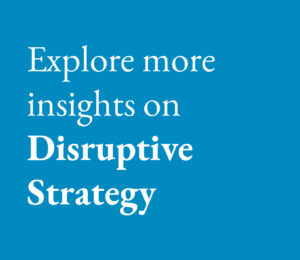When you envisioned your plans for 2020, did you include working remotely and wearing a face mask whenever you left home?
No one could have imagined that in a matter of weeks, a single case of a novel respiratory virus would evolve into a global health crisis, disrupt economies, and force businesses large and small to their knees. It is a dramatic and costly illustration of the butterfly effect and complexity.
But that is the life of an executive, is it not? Daily, we see unexpected challenges unfold all the time. Complexity is normal and yet it is not well understood. Given this practical reality, the question we must concern ourselves with is: How do you manage and lead complex phenomena so that you can achieve your intended outcomes?
Planning is the easy part; execution is where it gets tricky. Why? Because businesses, and the environments in which we operate, are dynamic. If you plan as though your business is static and anticipate everything to move linearly, you will be disappointed (at best) or caught flatfooted with sub-optimal results. Effective execution does not occur in the safety of orderly and linear process management. It emerges from complexity and well-led chaos. While you cannot control complex adaptive systems, you can influence them to establish conditions from which your intended outcomes can emerge.
In a recent conversation, a chief strategy officer of a large healthcare system expressed frustration about their organization’s ability to execute broadly on a very ambitious strategy. They were using Lean and had their priorities, projects and A3s, but they were not executing with the needed velocity or power. And they were not getting to where they wanted to be. We believe that executing strategies, particularly for large organizations, is a chaotic phenomenon that requires a different approach.
Process-driven solutions are great for controlling big, linear undertakings. If you do things the same way every time, you will get the same result every time. That kind of cause-and-effect thinking is useful in, say, assembly-line manufacturing or transactional work. Lean is derived from a manufacturing environment and its very purpose is intended to be orderly, predictable and controlled.
 Even project planning and program management methods assume a certain predictable order. However, what makes these methods so powerful in one environment can hamper organizational growth or transformation when undertaking a complex phenomenon.
Even project planning and program management methods assume a certain predictable order. However, what makes these methods so powerful in one environment can hamper organizational growth or transformation when undertaking a complex phenomenon.
Unlike an orderly process, where actors must do exactly what they are told to do, the actors in large-scale initiatives are agents operating locally and making decisions locally. In these cases, the agents are interacting with each other, being affected by their interactions with each other, thus altering their choices, their perspectives and their behaviors with each interaction. In this complex adaptive system, linear execution models are not appropriate.
It Is Really About Butterflies and Basketball
“It used to be thought that the events that changed the world were things like big bombs, maniac politicians, huge earthquakes, or vast population movements, but it has now been realized that this is a very old-fashioned view held by people totally out of touch with modern thought. The things that change the world, according to Chaos theory, are the tiny things. A butterfly flaps its wings in the Amazonian jungle, and subsequently a storm ravages half of Europe.”
— from Good Omens by Terry Pratchett and Neil Gaiman
Although the concept of the butterfly effect has long been debated, the identification of it as a distinct effect is credited to Edward Lorenz, a meteorologist and mathematician who successfully combined the two disciplines to create chaos theory.
Results that are a function of these complex adaptive systems come from independent actions that cannot be predicted and thus cannot be controlled. And yet that is the role of management: to predict and control in order to reliably deliver. So, how can reliability be generated without control? In fact, how can critical strategies be executed when the actors are operating like a roomful of cats?
Instead of following prescriptive rules when managing and leading a complex phenomenon, the challenge is to set the conditions. From these conditions, choices and behaviors among the agents will emerge that will give rise to your desired outcome.
When legendary UCLA basketball coach John Wooden started a new season, the first thing he did was make his players practice tying their shoelaces. Yes, the first few practices included significant time tying shoelaces! Why? Because loose shoelaces lead to blisters or sprained ankles, either of which is likely to result in injured players. That, in turn, can cause other repercussions. Also, tying shoelaces tightly requires intentional discipline, a be-here-now alertness. All of which goes a long way toward building a condition that is necessary for basketball success. This coach—who led his teams to 10 NCAA national championships—rarely talked about winning. Rather, he talked about what mattered, like tight shoelaces.
In Lean, the tying shoelaces module could be considered standard work. Thus, setting a condition to manage chaos does require a set of standard work. But the intent of the standard work is not to prescribe an action in a linear set of actions. Rather, in a complex phenomenon, the challenge is to develop the sufficient and necessary set of practices needed to create the requisite conditions. Let us not forget that in complex phenomena, the standard work is about setting conditions whereas, in linear phenomena, standard work is to ensure the mechanistic predictability of the system.
The Challenge of Herding Cats
If you approach the problem of herding a room of cats in a linear fashion, you may try picking up one cat and moving her near the door, then picking up the next cat, and so on. The problem is that cats—the agents in this system—are not static: They are dynamic.
They move where and when they want to move, and there is no way to predict where they will go next.
This sort of nonlinear complexity requires a different approach. Instead of trying to manage each cat individually, establish a condition whereby all the cats eventually move toward the door. For example, you can tilt the floor. Instead of following prescriptive rules when managing and leading a complex phenomenon, the challenge is to set the conditions. From these conditions, choices and behaviors among the agents will emerge that will give rise to your desired outcome.
To follow through with the example of Mr. Wooden, basketball is a perfect example of setting conditions to allow the emergence of an intended outcome. You have certain conditions in a basketball game. The athletes have muscular prowess and intentionally developed skills. There are some plays that are understood and yet cannot be scripted.
People know exactly what their roles are and what is expected of them within those roles. Also, people know some fundamental strategies: When only a few seconds remain in a game, and you are down by three points, your team gets in a position to execute a three-point shot. The ball is passed to Jon because he is the best player for that role.
The conditions guide behavior, but they also provide room for responses that emerge from the unexpected. And, when the conditions are right, order seems almost effortless.
Setting the Conditions for Breakthrough Performance
Here is a practical application: A client called us in to achieve a breakthrough in labor-management relations in their brand-new flagship distribution center. This state-of-the-art facility had implemented a pay-for-performance system for the warehouse and delivery associates. The facility and the incentives should have led to top-tier performance. However, although they had the best-paying contract in its region, the client also had the worst labor-management relationship, which is the worst-case scenario for an employer.
While the employees were making top dollar to stock trucks quickly, the client was beset with workplace vandalism, safety issues and late deliveries.
While able to provide exceptionally well for their families, the workers expressed frustration at having to defy the union principles of solidarity to generate said income. And the employees’ commitment to their families was repeatedly violated with the client’s bad practices in managing overtime and scheduling holidays.
The butterfly wings were embodied by an often-repeated comment made by the previous CEO. Upon implementing the new pay system seven years earlier, he had been asked, “What about worker loyalty?” (a synonym for solidarity). The CEO allegedly answered, “If you want loyalty, get a dog.”
His comment set a context that workers and dogs could be referred to in the same breath because they were held in the same regard. The high payroll of a pay-for-performance system subsequently resulted in the workplace vandalism, safety issues and late deliveries.
Employees often referred to the dog comment as what emphasized their frustrations, further stressing the conflicting forces of union solidarity, commitment to family and obstacles to that commitment.
To add insult to injury, each worker had to enter and leave the distribution center through a gate that had been previously installed so security personnel could check their bodies and bags for theft. Although the checks had not happened for a few years, every day the employees walked through that gate still reinforced their condition of not being respected.
What allowed for a breakthrough? Interviews and focus groups showed the executive team the conditions which they were managing and leading. Forums were established for executives, managers and workers to understand each other and to discover a common commitment to the employees’ families.
The new CEO removed the gate. Overtime and holiday scheduling were revamped to be more supportive of family commitments. A joint management and worker family picnic became a company tradition. It is hard to see each other as adversaries when your kids are playing together, squealing with joy. Also, it is evident that being a parent is the same no matter your work category. The outcome? Highest results in all measures, ranging from workplace safety to “in stock” to “on time.” Without mentioning customer experience, the right stock was delivered on time and in the correct quantity, which was exactly what was needed to elevate customer reviews.
Complex adaptive systems can feel chaotic, especially during a crisis, but that chaos is where the magic happens. Share on XWhen there is room to adjust course, take tangents and step into the unknown where interesting patterns can emerge. The challenge is then knowing how to leverage and influence those patterns to move the business forward.
Emergence is the dynamic whereby new outcomes are created as we bring different elements together. Understanding and managing emergence is an art to master as a leader of any complex enterprise.
This article appeared in the Fall 2020 issue of Insigniam Quarterly. To begin receiving IQ, go here.






